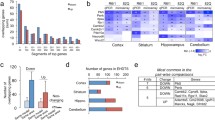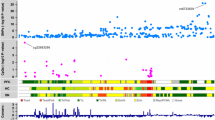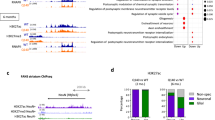Abstract
Mutations in the DHCR24 gene, which encodes the cholesterol biosynthesis enzyme 3ß-hydroxysterol-∆24 reductase, result in an autosomal recessive disease called desmosterolosis. Further, reduced expression of DHCR24 is found in the temporal cortex of Alzheimer’s disease patients. This suggests that variability in the regulatory regions of DHCR24 may contribute to the development of this neurodegenerative disease. In this work, we functionally characterised the proximal fragment of the human DHCR24 gene, for the first time. We show that the transcription of DHCR24 is initiated from a single CpG-rich promoter that is regulated by DNA methylation in some cell types. An activator sequence was also uncovered in the −1203/−665 bp region by reporter gene assays. Furthermore, sodium butyrate (a well-known HDAC inhibitor) increased DHCR24 expression in SH-SY5Y cells by recruiting acetylated core histones H3 and H4 to the enhancer region, as demonstrated by transient transfection and chromatin immunoprecipitation assays. Understanding the regulation of the DHCR24 gene may lead to alternative therapeutic strategies in at least some Alzheimer’s patients.






Similar content being viewed by others
References
Waterham HR, Koster J et al (2001) Mutations in the 3beta-hydroxysterol Delta24-reductase gene cause desmosterolosis, an autosomal recessive disorder of cholesterol biosynthesis. Am J Hum Genet 69(4):685–694. doi:10.1086/323473
FitzPatrick DR, Keeling JW et al (1998) Clinical phenotype of desmosterolosis. Am J Med Genet 75(2):145–152. doi:10.1002/(SICI)1096-8628(19980113)75:2<145:AID-AJMG5>3.0.CO;2-S
Greeve I, Hermans-Borgmeyer I et al (2000) The human DIMINUTO/DWARF1 homolog seladin-1 confers resistance to Alzheimer’s disease-associated neurodegeneration and oxidative stress. J Neurosci 20(19):7345–7352
Fuller PJ, Alexiadis M et al (2005) Seladin-1/DHCR24 expression in normal ovary, ovarian epithelial and granulosa tumours. Clin Endocrinol (Oxf) 63(1):111–115. doi:10.1111/j.1365-2265.2005.02308.x
Luciani P, Gelmini S et al (2005) Expression of the antiapoptotic gene seladin-1 and octreotide-induced apoptosis in growth hormone-secreting and nonfunctioning pituitary adenomas. J Clin Endocrinol Metab 90(11):6156–6161. doi:10.1210/jc.2005-0633
Biancolella M, Valentini A et al (2007) Effects of dutasteride on the expression of genes related to androgen metabolism and related pathway in human prostate cancer cell lines. Invest New Drugs 25(5):491–497. doi:10.1007/s10637-007-9070-7
Iivonen S, Hiltunen M et al (2002) Seladin-1 transcription is linked to neuronal degeneration in Alzheimer’s disease. Neuroscience 113(2):301–310
Vanmierlo T, Bloks VW et al. (2009). Alterations in brain cholesterol metabolism in the APPSLxPS1mut mouse, a model for Alzheimer’s disease. J Alzheimers Dis. doi:10.3233/JAD-2009-1209
Cecchi C, Rosati F et al (2008) Seladin-1/DHCR24 protects neuroblastoma cells against Abeta toxicity by increasing membrane cholesterol content. J Cell Mol Med 12(5B):1990–2002. doi:10.1111/j.1582-4934.2008.00216.x
Reijnen MJ, Peerlinck K et al (1993) Hemophilia B Leyden: substitution of thymine for guanine at position −21 results in a disruption of a hepatocyte nuclear factor 4 binding site in the factor IX promoter. Blood 82(1):151–158
Siegling S, Thyzel E et al (2006) Analysis of sequence variations in the promoter region of the human tissue factor pathway inhibitor 2 gene in apoplectic patients and blood donors. Ann Hematol 85(1):32–37. doi:10.1007/s00277-005-0023-y
Schulz V, Hendig D et al (2006) Mutational analysis of the ABCC6 gene and the proximal ABCC6 gene promoter in German patients with pseudoxanthoma elasticum. Hum Mutat 27(8):831. doi:10.1002/humu.9444
Hubner N, Wallace CA et al (2005) Integrated transcriptional profiling and linkage analysis for identification of genes underlying disease. Nat Genet 37(3):243–253. doi:10.1038/ng1522
Takai D, Jones PA (2003) The CpG island searcher: a new WWW resource. In Silico Biol 3(3):235–240
Cartharius K, Frech K et al (2005) MatInspector and beyond: promoter analysis based on transcription factor binding sites. Bioinformatics 21(13):2933–2942. doi:10.1093/bioinformatics/bti473
Yamashita R, Wakaguri H et al. DBTSS provides a tissue specific dynamic view of Transcription Start Sites. Nucleic Acids Res 38(Database issue): D98–104. doi:10.1093/nar/gkp1017
Tsuchihara K, Suzuki Y et al (2009) Massive transcriptional start site analysis of human genes in hypoxia cells. Nucleic Acids Res 37(7):2249–2263. doi:10.1093/nar/gkp066
Walczak-Drzewiecka A, Ratajewski M et al (2008) HIF-1alpha is up-regulated in activated mast cells by a process that involves calcineurin and NFAT. J Immunol 181(3):1665–1672
Vandesompele J, De Preter K et al (2002). Accurate normalization of real-time quantitative RT-PCR data by geometric averaging of multiple internal control genes. Genome Biol 3(7): RESEARCH0034
Ratajewski M, Van de Ven WJ et al (2008) The human pseudoxanthoma elasticum gene ABCC6 is transcriptionally regulated by PLAG family transcription factors. Hum Genet 124(5):451–463. doi:10.1007/s00439-008-0570-0
Aranyi T, Ratajewski M et al (2005) Identification of a DNA methylation-dependent activator sequence in the pseudoxanthoma elasticum gene, ABCC6. J Biol Chem 280(19):18643–18650. doi:10.1074/jbc.M501139200
Walczak-Drzewiecka A, Ratajewski M et al (2010) DNA methylation-dependent suppression of HIF1A in an immature hematopoietic cell line HMC-1. Biochem Biophys Res Commun 391(1):1028–1032
Dignam JD, Lebovitz RM et al (1983) Accurate transcription initiation by RNA polymerase II in a soluble extract from isolated mammalian nuclei. Nucleic Acids Res 11(5):1475–1489
Gardiner-Garden M, Frommer M (1987) CpG islands in vertebrate genomes. J Mol Biol 196(2):261–282
Carninci P, Sandelin A et al (2006) Genome-wide analysis of mammalian promoter architecture and evolution. Nat Genet 38(6):626–635. doi:10.1038/ng1789
Cihak A (1974) Biological effects of 5-azacytidine in eukaryotes. Oncology 30(5):405–422
Vesely J (1985) Mode of action and effects of 5-azacytidine and of its derivatives in eukaryotic cells. Pharmacol Ther 28(2):227–235
Stresemann C, Lyko F (2008) Modes of action of the DNA methyltransferase inhibitors azacytidine and decitabine. Int J Cancer 123(1):8–13. doi:10.1002/ijc.23607
Dangond F, Gullans SR (1998) Differential expression of human histone deacetylase mRNAs in response to immune cell apoptosis induction by trichostatin A and butyrate. Biochem Biophys Res Commun 247(3):833–837. doi:10.1006/bbrc.1998.8891
Benvenuti S, Luciani P et al (2005) Estrogen and selective estrogen receptor modulators exert neuroprotective effects and stimulate the expression of selective Alzheimer’s disease indicator-1, a recently discovered antiapoptotic gene, in human neuroblast long-term cell cultures. J Clin Endocrinol Metab 90(3):1775–1782. doi:10.1210/jc.2004-0066
Bonaccorsi L, Luciani P et al (2008) Androgen receptor regulation of the seladin-1/DHCR24 gene: altered expression in prostate cancer. Lab Invest 88(10):1049–1056. doi:10.1038/labinvest.2008.80
Wang Y, Rogers PM et al (2008) The selective Alzheimer’s disease indicator-1 gene (Seladin-1/DHCR24) is a liver X receptor target gene. Mol Pharmacol 74(6):1716–1721. doi:10.1124/mol.108.048538
Cai HN, Zhang Z et al (2001) Genomic context modulates insulator activity through promoter competition. Development 128(21):4339–4347
Beer MA, Tavazoie S (2004) Predicting gene expression from sequence. Cell 117(2):185–198
Nguyen DH, D’Haeseleer P (2006) Deciphering principles of transcription regulation in eukaryotic genomes. Mol Syst Biol 2:0012–2006. doi:10.1038/msb4100054
Sandelin A, Carninci P et al (2007) Mammalian RNA polymerase II core promoters: insights from genome-wide studies. Nat Rev Genet 8(6):424–436. doi:10.1038/nrg2026
Frith MC, Valen E et al (2008) A code for transcription initiation in mammalian genomes. Genome Res 18(1):1–12. doi:10.1101/gr.6831208
Chervenak AP, Basu P et al (2006) Identification, characterization, and expression pattern of the chicken EKLF gene. Dev Dyn 235(7):1933–1940. doi:10.1002/dvdy.20829
Gray S, Wang B et al (2007) Regulation of gluconeogenesis by Kruppel-like factor 15. Cell Metab 5(4):305–312. doi:10.1016/j.cmet.2007.03.002
Jeong KH, Kim SK et al (2009) Immunohistochemical localization of Kruppel-like factor 6 in the mouse forebrain. Neurosci Lett 453(1):16–20. doi:10.1016/j.neulet.2009.02.002
Rochette-Egly C, Fromental C et al (1990) General repression of enhanson activity by the adenovirus-2 E1A proteins. Genes Dev 4(1):137–150
Vukic V, Callaghan D et al (2009) Expression of inflammatory genes induced by beta-amyloid peptides in human brain endothelial cells and in Alzheimer’s brain is mediated by the JNK-AP1 signaling pathway. Neurobiol Dis 34(1):95–106. doi:10.1016/j.nbd.2008.12.007
Camins A, Verdaguer E et al (2007) Inhibition of ataxia telangiectasia-p53-E2F-1 pathway in neurons as a target for the prevention of neuronal apoptosis. Curr Drug Metab 8(7):709–715
Chen Z, Friedrich GA et al (1994) Transcriptional enhancer factor 1 disruption by a retroviral gene trap leads to heart defects and embryonic lethality in mice. Genes Dev 8(19):2293–2301
Yasunami M, Suzuki K et al (1995) Molecular characterization of cDNA encoding a novel protein related to transcriptional enhancer factor-1 from neural precursor cells. J Biol Chem 270(31):18649–18654
Naye F, Treguer K et al (2007) Differential expression of two TEF-1 (TEAD) genes during Xenopus laevis development and in response to inducing factors. Int J Dev Biol 51(8):745–752. doi:10.1387/ijdb.072375fn
Pelegri C, Duran-Vilaregut J et al (2008) Cell cycle activation in striatal neurons from Huntington’s disease patients and rats treated with 3-nitropropionic acid. Int J Dev Neurosci 26(7):665–671. doi:10.1016/j.ijdevneu.2008.07.016
Milagre I, Nunes MJ et al (2008) Transcriptional regulation of the human CYP46A1 brain-specific expression by Sp transcription factors. J Neurochem 106(2):835–849
El-Osta A, Baker EK et al (2001) Profiling methyl-CpG specific determinants on transcriptionally silent chromatin. Mol Biol Rep 28(4):209–215
Antequera F (2003) Structure, function and evolution of CpG island promoters. Cell Mol Life Sci 60(8):1647–1658. doi:10.1007/s00018-003-3088-6
Eckhardt F, Lewin J et al (2006) DNA methylation profiling of human chromosomes 6, 20 and 22. Nat Genet 38(12):1378–1385. doi:10.1038/ng1909
Nan X, Ng HH et al (1998) Transcriptional repression by the methyl-CpG-binding protein MeCP2 involves a histone deacetylase complex. Nature 393(6683):386–389. doi:10.1038/30764
Douet V, Heller MB et al (2007) DNA methylation and Sp1 binding determine the tissue-specific transcriptional activity of the mouse Abcc6 promoter. Biochem Biophys Res Commun 354(1):66–71. doi:10.1016/j.bbrc.2006.12.151
Guo H, Lin Y et al (2007) Tissue factor pathway inhibitor-2 was repressed by CpG hypermethylation through inhibition of KLF6 binding in highly invasive breast cancer cells. BMC Mol Biol 8:110. doi:10.1186/1471-2199-8-110
Pieper HC, Evert BO et al (2008) Different methylation of the TNF-alpha promoter in cortex and substantia nigra: Implications for selective neuronal vulnerability. Neurobiol Dis 32(3):521–527. doi:10.1016/j.nbd.2008.09.010
Peri A, Danza G et al (2009) New insights on the neuroprotective role of sterols and sex steroids: the seladin-1/DHCR24 paradigm. Front Neuroendocrinol 30(2):119–129. doi:10.1016/j.yfrne.2009.03.006
Silva PN, Gigek CO et al (2008) Promoter methylation analysis of SIRT3, SMARCA5, HTERT and CDH1 genes in aging and Alzheimer’s disease. J Alzheimers Dis 13(2):173–176
Homman N, Heuertz S et al (1987) Time dependence of X gene reactivation induced by 5-azacytidine: possible progressive restructuring of chromatin. Exp Cell Res 172(2):481–486
Van Lint C, Emiliani S et al (1996) The expression of a small fraction of cellular genes is changed in response to histone hyperacetylation. Gene Expr 5(4–5):245–253
Hahnen E, Hauke J et al (2008) Histone deacetylase inhibitors: possible implications for neurodegenerative disorders. Expert Opin Investig Drugs 17(2):169–184. doi:10.1517/13543784.17.2.169
Acknowledgments
The authors express their gratitude to Dr Lukasz Pulaski for helpful discussions. This work was supported by the Grant No. N N301 164335 from the Polish Ministry of Science and Higher Education, and by the statutory funds of the Institute of Medical Biology and University of Lodz.
Author information
Authors and Affiliations
Corresponding author
Electronic supplementary material
Below is the link to the electronic supplementary material.
Rights and permissions
About this article
Cite this article
Drzewinska, J., Walczak-Drzewiecka, A. & Ratajewski, M. Identification and analysis of the promoter region of the human DHCR24 gene: involvement of DNA methylation and histone acetylation. Mol Biol Rep 38, 1091–1101 (2011). https://doi.org/10.1007/s11033-010-0206-z
Received:
Accepted:
Published:
Issue Date:
DOI: https://doi.org/10.1007/s11033-010-0206-z




